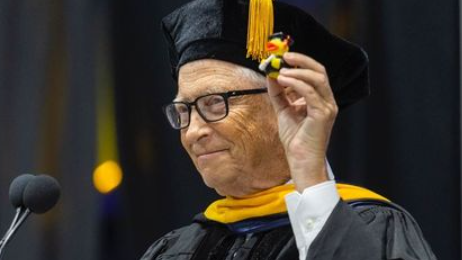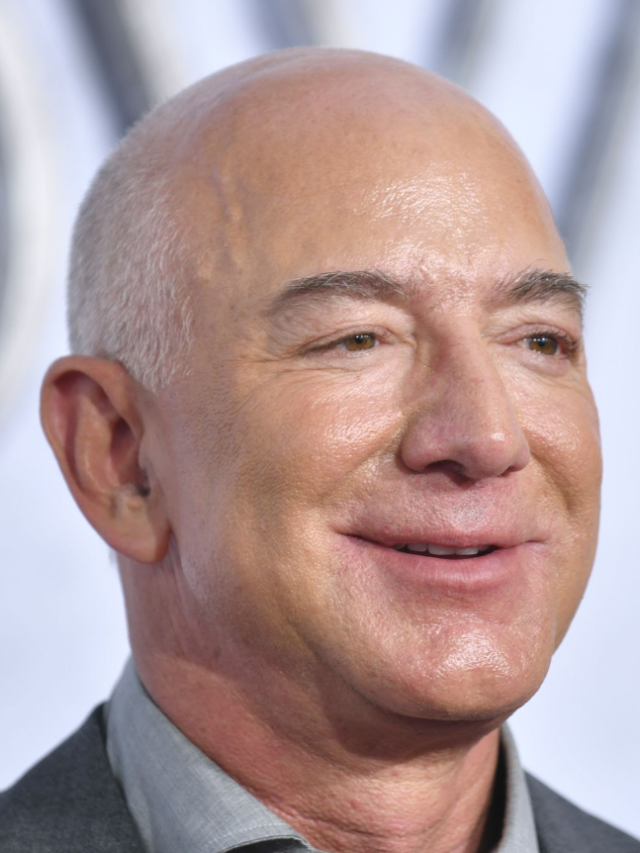Bill Gates, born on October 28, 1955, in Seattle, Washington, is a renowned entrepreneur, software developer, and philanthropist. Gates developed an early interest in computing and programming, leading him to co-found Microsoft with his childhood friend Paul Allen in 1975. Their pioneering vision and innovation revolutionized the personal computer industry, making Microsoft the world’s leading software company.
Gates played a crucial role in developing the Windows operating system, which became a staple in homes and businesses worldwide. Under his leadership, Microsoft grew exponentially, and Gates became one of the richest individuals globally.
In 2000, he shifted his focus to philanthropy, establishing the Bill & Melinda Gates Foundation with his then-wife, Melinda. The foundation tackles global challenges, including poverty, education, and healthcare, making significant strides in eradicating diseases like polio and malaria.
Despite stepping down from daily operations at Microsoft in 2008, Gates continues to influence the tech industry and global philanthropy. His commitment to using his wealth for social good has earned him widespread admiration, solidifying his legacy as a visionary leader and benevolent force in modern history.

Table of Contents
Bill Gates: Early Life and Education:
Bill Gates came into the world on October 28, 1955, in Seattle, Washington. His full name is William Henry Gates III, and he grew up in a well-to-do family with his parents, William H. Gates Sr. and Mary Maxwell Gates. His father was a prominent lawyer, and his mother was a respected businesswoman and civic leader. This nurturing environment set the stage for his future success. Gates showed an early interest in technology. At the age of 13, he attended Lakeside School, a private preparatory school known for its rigorous academic environment. It was at Lakeside that Gates was introduced to computers for the first time. The school had a computer club, and Gates quickly became fascinated with the machine. He and his friends, including Paul Allen, spent countless hours experimenting with programming, pushing the limits of what the computer could do. His passion for coding led to his first entrepreneurial venture. Gates, along with Allen and two other students, created a timekeeping software for the school’s computer system. This early experience not only honed his programming skills but also sparked his entrepreneurial spirit. In 1973, Gates enrolled at Harvard University, one of the most prestigious institutions in the world. However, his heart was not entirely in his studies. He spent much of his time in the computer lab, continuing to pursue his passion for programming. During his time at Harvard, he developed a version of the programming language BASIC for the first microcomputer, the Altair 8800. This project marked the beginning of Gates’ professional career in technology. In 1975, Gates made a bold decision. Recognizing the immense potential of the emerging personal computer industry, he dropped out of Harvard to start his own company with Paul Allen. This company would eventually become Microsoft, transforming the tech landscape and making Gates one of the most influential figures in the world
The Birth of Microsoft:
Bill Gates’ journey to founding Microsoft began with a shared passion for computers with his childhood friend, Paul Allen. In the early 1970s, while still in high school, Bill Gates and Allen spent countless hours programming on early computer systems. Their enthusiasm continued into college, with Gates attending Harvard and Allen working at Honeywell. Despite their promising paths, they couldn’t ignore the booming potential of the nascent computer industry. In 1975, their opportunity arrived. The Altair 8800, one of the first personal computers, was released. Seeing a chance to make an impact, Gates and Allen contacted the manufacturer, MITS, offering to create software for the Altair. They developed a BASIC interpreter, which was a success and solidified their belief in the future of personal computing. Driven by this initial success, Gates left Harvard, and together with Allen, they founded Microsoft in Albuquerque, New Mexico, where MITS was located. Their mission was clear: to develop software that would make computers accessible and useful to everyone. Gates took on the role of CEO, bringing his visionary ideas and relentless work ethic to the fledgling company. The name “Microsoft” was a blend of “microcomputer” and “software,” reflecting their focus. Their first major break came when IBM approached them in 1980 to develop an operating system for its new line of personal computers. Gates and his team acquired an existing operating system, modified it, and delivered MS-DOS. This partnership with IBM skyrocketed Microsoft to prominence. By the mid-1980s, Microsoft was not just a company; it was the driving force behind the software revolution, setting the stage for the tech giant it would become. The birth of Microsoft marked the beginning of a new era in technology, transforming how the world used and interacted with computers.
Bill Gates: The Rise of a Tech Giant
Bill Gates’ journey to becoming a tech giant began in 1975 when he and his childhood friend, Paul Allen, founded Microsoft. The duo saw the potential in the emerging personal computer industry and set out to develop software that would change the way people used technology. Their first big success came with the creation of a BASIC interpreter for the Altair 8800, an early personal computer. This success laid the foundation for Microsoft’s growth and innovation. In the early 1980s, Microsoft struck a deal with IBM to provide an operating system for its new line of personal computers. Bill Gates and his team quickly developed MS-DOS, which became the standard operating system for IBM PCs. This partnership with IBM was a game-changer, catapulting Microsoft into the forefront of the tech industry. The real breakthrough came with the launch of Windows in 1985. Windows introduced a graphical user interface that made computers more accessible and user-friendly. It allowed users to navigate their computers using a mouse and visual icons rather than typing commands. The initial versions of Windows faced some challenges, but Microsoft’s persistence paid off with the release of Windows 3.0 in 1990, which was a massive success. As Microsoft grew, Gates’ leadership and vision continued to drive the company forward. They expanded their product line to include Microsoft Office, a suite of productivity tools that included Word, Excel, and PowerPoint. This software suite became an essential tool for businesses and individuals alike, solidifying Microsoft’s dominance in the software market. By the mid-1990s, Microsoft was not only a tech company but a household name. Gates’ ability to foresee the future of technology and his relentless pursuit of innovation had transformed Microsoft into a global powerhouse. The rise of Microsoft under Bill Gates’ leadership is a testament to his vision, determination, and ability to navigate the rapidly evolving tech landscape
Bill Gates: Windows Revolution
The Windows Revolution was a pivotal moment in the tech industry, and Bill Gates was at the heart of it. In the early 1980s, personal computers were becoming more popular, but they were still difficult for the average person to use. Most computers operated through command-line interfaces, which required users to type in commands to perform tasks. Gates saw an opportunity to make computers more user-friendly and accessible to the masses. In 1985, Microsoft launched the first version of Windows. This operating system introduced a graphical user interface (GUI) that allowed users to interact with their computers using visual icons and a mouse, rather than typing commands. The initial version of Windows was not an immediate success, but it laid the groundwork for future improvements. Windows 3.0, released in 1990, was a game-changer. It featured improved graphics, more memory support, and a more intuitive interface. This version of Windows was widely adopted and solidified Microsoft’s dominance in the operating system market. With Windows, Microsoft provided a platform that was not only powerful but also easy to use, which appealed to both consumers and businesses.The success of Windows 3.0 was followed by Windows 95, which introduced several new features that further revolutionized personal computing. Windows 95 integrated support for the internet, included the Start menu, taskbar, and minimized the learning curve for new users. The launch of Windows 95 was accompanied by a massive marketing campaign, making it one of the most anticipated software releases ever. Under Gates’ leadership, Microsoft continued to innovate and release new versions of Windows, each one building on the success of its predecessors. Windows became the standard operating system for personal computers, dominating the market and making Microsoft one of the most influential tech companies in the world. The Windows Revolution was not just about a software product; it was about changing the way people interacted with technology. Bill Gates’ vision and relentless pursuit of making technology accessible to everyone played a crucial role in shaping the digital age. The user-friendly interface of Windows helped bridge the gap between people and computers, making technology an integral part of everyday life.
Bill Gates: Microsoft Office and Software Dominance
Bill Gates’ vision for Microsoft extended beyond operating systems; he also saw the potential to dominate the software market with productivity tools. This led to the creation of Microsoft Office, a suite of applications designed to enhance productivity for both individuals and businesses. The journey began in 1989 when Microsoft launched its first version of Office. This suite included Word, Excel, and PowerPoint, each serving a different purpose but working seamlessly together. Word was designed for word processing, Excel for spreadsheets, and PowerPoint for creating presentations. The integration of these tools into a single package was a groundbreaking move that set Microsoft apart from its competitors. One of the key reasons for the success of Microsoft Office was its user-friendly interface. Gates and his team focused on making the software intuitive and easy to use, which was a significant shift from the complex and often frustrating interfaces of other productivity tools available at the time. This focus on user experience helped Office quickly become the go-to software for businesses and individuals alike. Microsoft didn’t stop at just launching Office; they continually improved it. Regular updates and new features made users stay interested and loyal By the mid-1990s, Office had become the industry standard. Its compatibility with Windows operating systems further cemented its dominance, as most personal computers were running Windows by this time. Gates’ strategy of bundling multiple productivity tools into one suite paid off immensely. Businesses adopted Office en masse because it provided a comprehensive solution for their needs, from writing documents to managing data and delivering presentations. This widespread adoption made Microsoft Office a cornerstone of the modern workplace. The dominance of Microsoft Office was not just a business success; it also had a cultural impact. Terms like “Word document” and “PowerPoint presentation” became part of everyday language. Gates’ vision and Microsoft’s execution transformed the way people worked, making productivity software an essential part of both professional and personal life. Through continuous innovation and a deep understanding of user needs, Bill Gates led Microsoft to not only create but also dominate the productivity software market with Microsoft Office. This achievement is a testament to Gates’ foresight and Microsoft’s commitment to enhancing user experience, making Office a ubiquitous tool in the world of business and beyond
Navigating Competition and Legal Challenges
In the dynamic world of technology, Bill Gates has been a key figure in navigating competition and legal challenges. As the co-founder of Microsoft, Bill Gates spearheaded the company through numerous competitive landscapes and legal battles. One of the landmark cases involved allegations of anti-competitive behavior, where Microsoft was accused of using its dominant position in the market to stifle competition. Through strategic legal maneuvers and negotiations, Gates and his team managed to reach settlements and maintain Microsoft’s position in the industry.
Furthermore, Gates understood the importance of innovation and staying ahead of the curve. He ensured that Microsoft consistently rolled out new features and updates, keeping users engaged and loyal. This proactive approach not only helped to retain customers but also solidified Microsoft’s position as a leader in the technology sector. Gates’ leadership style was marked by a combination of vision, determination, and adaptability. In the face of competition, he remained focused on long-term goals while effectively addressing immediate challenges. Additionally, Bill Gates emphasized the importance of ethical business practices, advocating for transparency and integrity in all dealings. Overall, Bill Gates’ ability to navigate competition and legal challenges stemmed from his strategic mindset, commitment to innovation, and dedication to upholding ethical standards. His legacy continues to inspire entrepreneurs and business leaders worldwide to tackle obstacles head-on while staying true to their values.
Philanthropy Begins
Bill Gates’ journey into philanthropy began with a simple yet profound idea: to make a positive impact on the world. After co-founding Microsoft and experiencing tremendous success in the tech industry, Gates shifted his focus to giving back to society. Alongside his wife, Melinda, he established the Bill Gates& Melinda Gates Foundation in 2000, marking the start of their philanthropic endeavors. Their foundation aimed to address global challenges such as poverty, disease, and lack of access to education. Gates recognized that his wealth could be a powerful tool for creating meaningful change and improving the lives of millions worldwide. Through strategic investments and partnerships, the foundation tackled issues like infectious diseases, improving healthcare systems, and promoting agricultural development in impoverished regions. Gates’ approach to philanthropy was marked by innovation and a commitment to measurable results. He believed in applying business principles to charitable efforts, emphasizing the importance of data-driven decision-making and accountability. This approach led to significant breakthroughs in areas such as eradicating polio, reducing malaria deaths, and increasing access to clean water and sanitation. Furthermore, Gates used his platform to advocate for philanthropy and inspire others to join the cause. Through initiatives like the Giving Pledge, he encouraged fellow billionaires to pledge the majority of their wealth to charitable causes, creating a ripple effect of generosity and impact. Overall, Bill Gates’ journey into philanthropy represents a remarkable transformation from tech pioneer to global humanitarian. His dedication to making the world a better place continues to drive positive change and inspire others to use their resources for the greater good.
The Bill & Melinda Gates Foundation
The Bill Gates & Melinda Gates Foundation stands as a beacon of hope and innovation in the realm of philanthropy. Founded by Bill Gates, the co-founder of Microsoft, and his wife Melinda in the year 2000, the foundation embodies their shared vision of improving lives and advancing equity worldwide. With an unwavering commitment to tackling some of the most pressing global challenges, the foundation focuses on a diverse range of areas including global health, education, poverty alleviation, and access to technology. Through strategic investments, partnerships, and innovative approaches, the foundation works tirelessly to create sustainable solutions that empower individuals and communities. One of the foundation’s most notable initiatives is its efforts to combat infectious diseases such as HIV/AIDS, malaria, and tuberculosis. By funding research, supporting healthcare systems, and advocating for equitable access to life-saving treatments and vaccines, the foundation has played a pivotal role in saving countless lives and driving progress towards a healthier world. In addition to its work in global health, the foundation is also deeply committed to improving educational opportunities for all. Recognizing the transformative power of education, particularly for marginalized communities, the foundation invests in initiatives aimed at enhancing school systems, empowering teachers, and expanding access to quality education, particularly in low-income regions. Furthermore, the foundation’s initiatives extend to areas such as agricultural development, gender equality, and economic empowerment, reflecting its holistic approach to addressing complex social issues. Overall, the Bill Gates & Melinda Gates Foundation serves as a shining example of philanthropy in action, leveraging the power of innovation, collaboration, and compassion to create positive change on a global scale. Through their tireless efforts, Bill and Melinda Gates have left an indelible mark on the world, inspiring others to join them in the pursuit of a more equitable and prosperous future.

Global Health Initiatives
Bill Gates has been a driving force behind numerous global health initiatives, demonstrating his unwavering commitment to improving healthcare worldwide. Through the Bill & Melinda Gates Foundation, Gates has spearheaded efforts to combat infectious diseases, strengthen healthcare systems, and promote access to life-saving treatments and vaccines. One of the foundation’s flagship initiatives is the fight against infectious diseases like HIV/AIDS, malaria, and tuberculosis. Recognizing the devastating impact of these diseases on communities around the world, Gates has invested significant resources in research, treatment, and prevention efforts. By funding innovative approaches and partnering with governments, NGOs, and healthcare organizations, the foundation has made substantial progress in reducing the burden of these diseases and saving lives. Moreover, Gates has been a vocal advocate for global health equity, emphasizing the importance of ensuring that everyone, regardless of their socioeconomic status or geographic location, has access to essential healthcare services. This commitment extends to initiatives aimed at improving maternal and child health, addressing malnutrition, and combating neglected tropical diseases. In addition to addressing specific diseases, Gates has also focused on strengthening healthcare systems to ensure they can effectively respond to emerging health threats and provide quality care to all. This includes investments in training healthcare workers, improving infrastructure, and implementing digital health solutions to enhance access and efficiency. Overall, Bill Gates’ global health initiatives reflect his belief that everyone deserves the opportunity to live a healthy and fulfilling life. Through his leadership and philanthropy, Gates has made significant strides towards achieving this vision, inspiring others to join him in the fight for a healthier, more equitable world.
Bill Gates Education and Learning Initiatives
Bill Gates has long been a staunch advocate for education and learning initiatives, recognizing the transformative power of knowledge in shaping individuals and societies. Through the Bill & Melinda Gates Foundation, Gates has spearheaded various initiatives aimed at improving educational opportunities and outcomes for people around the world. One of the foundation’s key focus areas is enhancing K-12 education, particularly in underserved communities. Gates believes that every child deserves access to a high-quality education that equips them with the skills and knowledge they need to succeed in school and beyond. To this end, the foundation invests in innovative approaches to teaching and learning, supports the development of effective educational resources, and advocates for policies that promote educational equity and excellence. Gates has also been a strong proponent of personalized learning, recognizing that students have diverse needs and learning styles. Through initiatives such as the Next Generation Learning Challenges, the foundation supports the development and implementation of technology-enabled learning solutions that adapt to individual students’ needs, interests, and abilities. Furthermore, Gates has focused on increasing access to higher education and improving outcomes for college students, particularly those from low-income backgrounds. The foundation provides scholarships, financial aid, and support services to help students overcome barriers to college access and success. In addition to supporting traditional education, Gates has championed the importance of lifelong learning and digital literacy in the 21st century. He believes that in an increasingly interconnected and technology-driven world, continuous learning is essential for personal and professional growth. The foundation invests in initiatives that promote digital skills development, online learning platforms, and workforce training programs to ensure that people of all ages have the opportunity to thrive in the digital age. Overall, Bill Gates’ education and learning initiatives reflect his commitment to unlocking the full potential of every individual through the power of education. Through his philanthropy and advocacy, Gates continues to drive progress towards a world where everyone has access to quality education and the opportunity to fulfill their aspirations.
Environmental and Sustainability Efforts
Bill Gates has emerged as a prominent figure in environmental and sustainability efforts, leveraging his influence and resources to address pressing global challenges. Through the Bill Gates & Melinda Gates Foundation and other initiatives, Gates has demonstrated a deep commitment to combating climate change, preserving biodiversity, and promoting sustainable development. Recognizing the urgency of climate change, Gates has invested in innovative solutions to reduce greenhouse gas emissions and transition to renewable energy sources. He supports research and development of clean technologies, such as renewable energy generation, energy storage, and carbon capture and storage, with the aim of accelerating the transition to a low-carbon economy. Moreover, Gates has been vocal about the importance of sustainable agriculture and food systems in mitigating climate change and addressing global hunger. The foundation invests in initiatives that promote climate-smart agricultural practices, improve access to nutritious and affordable food, and empower smallholder farmers to adapt to climate change. In addition to addressing climate change, Gates is actively involved in efforts to preserve biodiversity and protect natural ecosystems. He recognizes the critical role that forests, oceans, and other ecosystems play in regulating the Earth’s climate and supporting biodiversity. Through conservation projects and partnerships with environmental organizations, Gates works to safeguard these vital ecosystems for future generations. Furthermore, Gates advocates for policies and practices that promote sustainable development and equitable access to resources. He believes that addressing environmental challenges requires collaboration across sectors and countries, as well as innovative approaches that prioritize both people and the planet. Overall, Bill Gates’ environmental and sustainability efforts reflect his belief in the importance of taking action to protect the planet and ensure a sustainable future for all. Through his leadership and philanthropy, Gates continues to drive progress towards a more resilient and environmentally sustainable world.
Transition from Microsoft
After decades at the helm of Microsoft, Bill Gates embarked on a significant transition from the tech giant to focus more on philanthropy and global issues. In 2008, he stepped down from his day-to-day role at Microsoft to dedicate more time to the Bill & Melinda Gates Foundation, which he co-founded with his wife, Melinda. This transition marked a pivotal moment in Gates’ life, as he shifted his focus from leading a technology company to addressing some of the world’s most pressing challenges, including global health, education, and poverty. While he remained involved with Microsoft as a board member and advisor, his primary attention shifted towards leveraging his wealth and influence for the greater good. Gates’ transition from Microsoft also provided an opportunity for him to explore new interests and initiatives beyond the tech industry. He became increasingly involved in areas such as climate change, sustainable development, and public health, using his expertise and resources to drive meaningful change on a global scale. Despite stepping away from his leadership role at Microsoft, Gates’ impact on the technology industry and global innovation continued to be profound. Through his investments, mentorship, and advocacy, he remained a prominent figure in shaping the future of technology and entrepreneurship. Overall, Bill Gates’ transition from Microsoft represents a transformative chapter in his life journey, as he shifted his focus towards philanthropy, advocacy, and addressing some of the world’s most pressing challenges. Bill Gates’ inspiring legacy as a leader, innovator, and philanthropist continues to motivate future generations.
Authorship and Thought Leadership
Bill Gates has left a lasting mark not only as a tech pioneer but also as an author and thought leader. Through his books, articles, and public speaking engagements, Gates has shared insights and perspectives on a wide range of topics, from technology and business to global issues like health and education. One of Gates’ notable contributions to literature is his book “The Road Ahead,” published in 1995. In this book, Gates offered his vision of the future and how technology would shape it, providing readers with valuable insights into the digital revolution that was just beginning to unfold. Additionally, Gates has authored several other books, including “Business @ the Speed of Thought” and “How to Avoid a Climate Disaster,” where he delves into topics such as business strategy, innovation, and climate change. Through these books, Gates shares his expertise and provides practical advice for addressing complex challenges. Moreover, Gates is a prolific writer and commentator, regularly sharing his thoughts and opinions on various platforms, including his blog, social media, and op-ed articles. He uses his platform to raise awareness about pressing global issues and advocate for solutions that drive positive change. Gates’ thought leadership extends beyond writing to public speaking engagements and interviews, where he engages with audiences worldwide to share his insights and perspectives. Whether discussing the future of technology, the importance of philanthropy, or strategies for tackling global challenges, Gates’ thought leadership has inspired and influenced countless individuals and organizations. Overall, Bill Gates’ authorship and thought leadership have cemented his legacy as not only a tech visionary but also a respected voice in addressing some of the most pressing issues facing humanity today.
Personal Life and Interests
Beyond his professional endeavors, Bill Gates leads a multifaceted personal life marked by diverse interests and passions. Known for his voracious appetite for reading, Gates is an avid bibliophile, often recommending books and sharing insights on his favorite reads. His love for learning extends beyond literature to various subjects, including history, science, and philosophy. In addition to his intellectual pursuits, Gates is a dedicated family man, cherishing time spent with his wife, Melinda, and their three children. He values family bonding and actively participates in activities that strengthen their connection, whether it’s enjoying outdoor adventures or engaging in philanthropic endeavors together. Despite his busy schedule, Gates prioritizes maintaining a healthy lifestyle, emphasizing the importance of exercise and proper nutrition. He is known to engage in regular workouts and follows a balanced diet to stay fit and energized for his endeavors.Gates also has a keen interest in technology and innovation outside of his professional responsibilities. He stays abreast of the latest advancements in science and technology, often investing in promising startups and initiatives that have the potential to drive positive change in the world. Moreover, Gates is passionate about giving back to society and making a meaningful impact through philanthropy. Alongside his wife, Melinda, he co-founded the Bill & Melinda Gates Foundation, which focuses on addressing global challenges such as poverty, disease, and lack of access to education. Overall, Bill Gates’ personal life and interests reflect a man of diverse passions, from intellectual pursuits and family values to health, technology, and philanthropy. His commitment to lifelong learning, personal growth, and making a difference in the world continues to inspire people worldwide.
Legacy and Impact
Bill Gates leaves behind a towering legacy and a profound impact that spans multiple domains. As the co-founder of Microsoft, Gates revolutionized the technology industry, shaping the way we live, work, and communicate in the digital age. His visionary leadership and relentless pursuit of innovation propelled Microsoft to become one of the most influential companies in the world. Beyond his contributions to technology, Gates’ legacy is defined by his unparalleled philanthropy and dedication to improving lives globally. Through the Bill & Melinda Gates Foundation, he tackled some of humanity’s most pressing challenges, from eradicating diseases like polio and malaria to promoting access to education and healthcare for the underserved. Gates’ impact on education is particularly notable, as he advocated for personalized learning and invested in initiatives aimed at empowering students and educators worldwide. His belief in the transformative power of education has helped millions of individuals unlock their potential and pursue brighter futures. Moreover, Gates’ commitment to addressing climate change and promoting sustainability underscores his broader impact on environmental stewardship. By investing in clean energy technologies and advocating for policies to reduce carbon emissions, he has contributed to efforts to mitigate the impacts of climate change and build a more sustainable future for generations to come. Overall, Bill Gates’ legacy is characterized by innovation, philanthropy, and a relentless pursuit of progress. His influence extends far beyond the realms of technology and business, touching countless lives and leaving an indelible mark on the world. As a visionary leader and compassionate humanitarian, Gates continues to inspire and empower others to drive positive change and make a difference in the world.

More Inspiration stories


